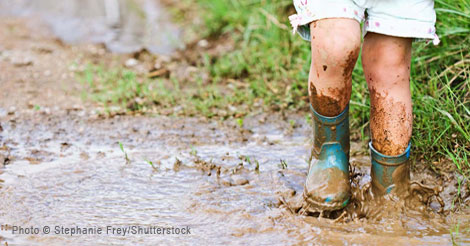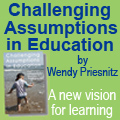|

A Little Dirt Won’t Hurt Them
By Kate Greene
Playing outside in the dirt might not be all that convenient for the parents who have to clean the kids up later, but there are many benefits.
The other day, I told my kids that Earth Day is coming up on April 22. Levi, the littlest one, said, “Oh goodie, that means we can get dirty!” Why, yes you can, Levi! Although that’s obviously not the exact intention of Earth Day, getting dirty might not be such a bad activity for that occasion…and many others too.
We’ve all heard about those parents who worry so much about their kids’ well-being that they smother them. “Helicopter parenting” is one term used to describe the ways some of us try to protect our children and even young people from every danger out there, both physical and emotional, while at the same time pushing them to achieve goals that we’ve set for them. Well, I think that keeping them too clean in order to protect them from germs and whatever else we fear might be lurking in “dirt” is part of that over-wrought parenting style. And I don’t think it’s good for our kids.
Physical Health
Not that many years ago, kids played in the dirt – they dug in sandboxes, made forts with sticks and mud, waded in streams, and played with worms, dogs, and other animals. Unfortunately, our fears about the dangers lurking in the muck, and a push toward over-sanitization, keep kids from doing what comes naturally, which is to go outside and get dirty.
Aside from the proven dangers of antibacterial soaps, which contain triclosan, a harmful hormone disruptor that is also thought to create bacteria that are resistant to antibiotics, ultraclean environments can actually contribute to the development of allergies, asthma, and other autoimmune diseases. In studies of what is called the Hygiene Hypothesis, researchers are concluding that organisms like the millions of healthy bacteria, viruses, and parasites that enter the body along with the dirt help develop healthy immune systems.
“What a child is doing when he puts things in his mouth is allowing his immune response to explore his environment,” Mary Ruebush, a microbiology and immunology instructor, wrote in her book Why Dirt Is Good. “Not only does this allow for ‘practice’ of immune responses, which will be necessary for protection, but it also plays a critical role in teaching the immature immune response what is best ignored.”
So don’t be concerned if you child comes home covered in mud and even ingests some by accident while using his senses of taste and smell to explore the world. At the same time, it’s wise to be on guard against possible soil contamination in your child’s play area that could be due to heavy metals such as lead and arsenic, which occur surprisingly often in urban soil.
Mental Health
In his landmark book Last Child in the Woods, Richard Louv brought together cutting- edge studies that pointed to direct exposure to Nature as essential not only for a child’s healthy physical development but also for her emotional health. He points to the growing body of evidence linking the lack of Nature in children’s lives and the rise in attention disorders and depression.
Studies have shown that simply having contact with dirt, whether it’s through making mud pies, digging holes, or even gardening can significantly improve a child’s mood and reduce her level of anxiety and stress (adults’ too!). Research has also found that playing in the dirt can even improve classroom performance, which is a good argument against decreasing recess time. And remember that bacteria found in soil? It apparently helps produce happiness-promoting hormone serotonin.
Of course, a kid can get dirty playing indoors too. But there is lots of evidence that, aside from all the other benefits I have mentioned, kids who play outdoors become more adventurous, more self-motivated, and better able to understand and assess risk.
So give your little ones a bucket and shovel, or just a kitchen bowl and some spoons, and let them play in the dirt or the sand. Or let them help you dig in the garden. (Yes, playing in the dirt is good for parents too!)
Learn More
Why Dirt Is Good: 5 Ways to Make Germs Your Friends by Mary Ruebush (Kaplan Publishing, 2009)
The Wild Life Of Our Bodies: Predators, Parasites, and Partners That Shape Who We Are Today by Rob Dunn (Harper Perennial, 2014)
I Love Dirt!: 52 Activities to Help You and Your Kids Discover the Wonders of Nature by Jennifer Ward and Richard Louv (Roost Books, 2008)
Last Child in the Woods: Saving Our Children From Nature-Deficit Disorder by Richard Louv (Algonquin Books, 2008)
Kate Greene is a freelance writer and mom who lives on Canada’s east coast with her family of five people and three animals.
Copyright © Life Media
Privacy Policy
 



|

